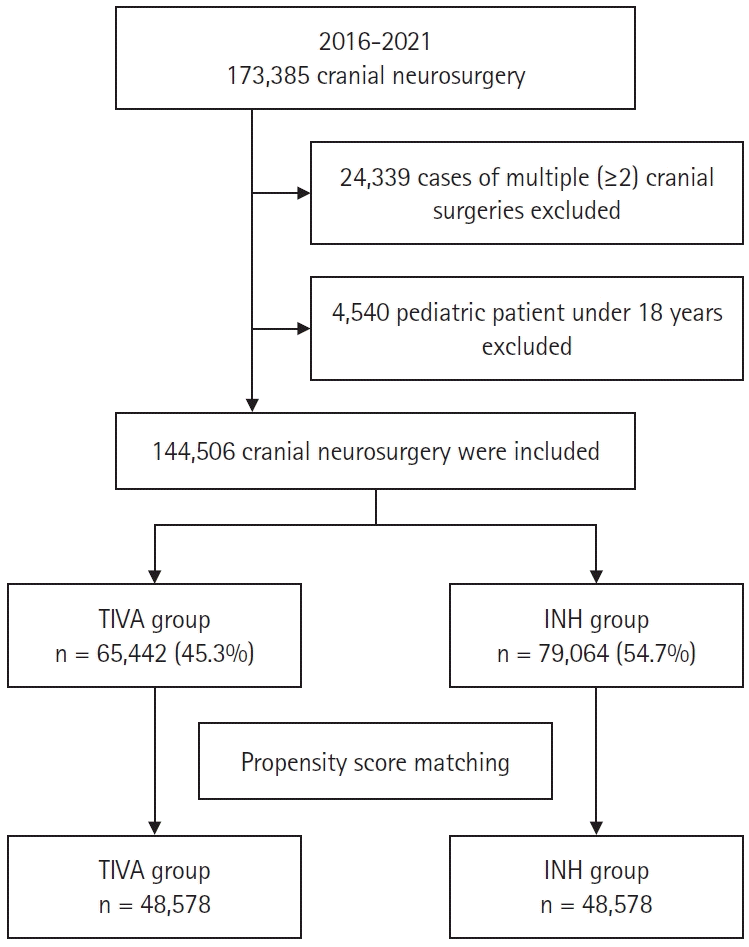1. Peters EJ, Robinson M, Serletis D. Systematic review of enhanced recovery after surgery in patients undergoing cranial surgery. World Neurosurg. 2022; 158:279–89.e1.

2. Dasenbrock HH, Liu KX, Devine CA, Chavakula V, Smith TR, Gormley WB, et al. Length of hospital stay after craniotomy for tumor: a national surgical quality improvement program analysis. Neurosurg Focus. 2015; 39:E12.

3. Missios S, Bekelis K. Drivers of hospitalization cost after craniotomy for tumor resection: creation and validation of a predictive model. BMC Health Serv Res. 2015; 15:85.

4. Senders JT, Muskens IS, Cote DJ, Goldhaber NH, Dawood HY, Gormley WB, et al. Thirty-day outcomes after craniotomy for primary malignant brain tumors: a national surgical quality improvement program analysis. Neurosurgery. 2018; 83:1249–59.
5. Nguyen A, Mandavalli A, Diaz MJ, Root KT, Patel A, Casauay J, et al. Neurosurgical anesthesia: optimizing outcomes with agent selection. Biomedicines. 2023; 11:372.

6. Cole CD, Gottfried ON, Gupta DK, Couldwell WT. Total intravenous anesthesia: advantages for intracranial surgery. Neurosurgery. 2007; 61(5 Suppl 2):369–77.
7. Liu CC, Chen IW, Liu PH, Wu JY, Liu TH, Huang PY, et al. Efficacy of propofol-based anesthesia against risk of brain swelling during craniotomy: a meta-analysis of randomized controlled studies. J Clin Anesth. 2024; 92:111306.

8. Thwaites A, Edmends S, Smith I. Inhalation induction with sevoflurane: a double-blind comparison with propofol. Br J Anaesth. 1997; 78:356–61.

9. Shan J, Sun L, Wang D, Li X. Comparison of the neuroprotective effects and recovery profiles of isoflurane, sevoflurane and desflurane as neurosurgical pre-conditioning on ischemia/reperfusion cerebral injury. Int J Clin Exp Pathol. 2015; 8:2001–9.
10. Makito K, Matsui H, Fushimi K, Yasunaga H. Volatile versus total intravenous anesthesia for cancer prognosis in patients having digestive cancer surgery. Anesthesiology. 2020; 133:764–73.

11. Choi HR, Song IA, Oh TK. Association between surgical volume and outcomes after craniotomy for brain tumor removal: a South Korean nationwide cohort study. J Clin Neurosci. 2022; 100:75–81.

12. Rosenbaum PR, Rubin DB. Reducing bias in observational studies using subclassification on the propensity score. J Am Stat Assoc. 1984; 79:516–24.

13. Nasr DM, Tomasini S, Prasad A, Rabinstein AA. Acute brain diseases as triggers for stress cardiomyopathy: clinical characteristics and outcomes. Neurocrit Care. 2017; 27:356–61.

14. Wang B, Wu Q, Liao J, Zhang S, Liu H, Yang C, et al. Propofol induces cardioprotection against ischemia-reperfusion injury via suppression of transient receptor potential vanilloid 4 channel. Front Pharmacol. 2019; 10:1150.

15. Jiménez-Martínez E, Cuervo G, Hornero A, Ciercoles P, Gabarrós A, Cabellos C, et al. Risk factors for surgical site infection after craniotomy: a prospective cohort study. Antimicrob Resist Infect Control. 2019; 8:69.

16. Koo BW, Sim JB, Shin HJ, Kim DW, Kang SB, Do SH, et al. Surgical site infection after colorectal surgery according to the main anesthetic agent: a retrospective comparison between volatile anesthetics and propofol. Korean J Anesthesiol. 2016; 69:332–40.

17. Chen RM, Chen TG, Chen TL, Lin LL, Chang CC, Chang HC, et al. Anti-inflammatory and antioxidative effects of propofol on lipopolysaccharide-activated macrophages. Ann N Y Acad Sci. 2005; 1042:262–71.

18. Kotani N, Hashimoto H, Sessler DI, Yasuda T, Ebina T, Muraoka M, et al. Expression of genes for proinflammatory cytokines in alveolar macrophages during propofol and isoflurane anesthesia. Anesth Analg. 1999; 89:1250–6.

19. Chu CH, David Liu D, Hsu YH, Lee KC, Chen HI. Propofol exerts protective effects on the acute lung injury induced by endotoxin in rats. Pulm Pharmacol Ther. 2007; 20:503–12.

20. Yi S, Tao X, Wang Y, Cao Q, Zhou Z, Wang S. Effects of propofol on macrophage activation and function in diseases. Front Pharmacol. 2022; 13:964771.

21. Engelhard K, Werner C. Inhalational or intravenous anesthetics for craniotomies? Pro inhalational. Curr Opin Anaesthesiol. 2006; 19:504–8.

22. Badenes R, Nato CG, Pena JD, Bilotta F. Inhaled anesthesia in neurosurgery: Still a role? Best Pract Res Clin Anaesthesiol. 2021; 35:231–40.

23. Ahn HJ. Anesthesia and cancer recurrence: a narrative review. Anesth Pain Med (Seoul). 2024; 19:94–108.

24. Gu L, Pan X, Wang C, Wang L. The benefits of propofol on cancer treatment: decipher its modulation code to immunocytes. Front Pharmacol. 2022; 13:919636.

25. Cheng Y, Zheng L, Yang C, Zhang W, Wang H. Propofol inhibits proliferation and migration of glioma cells by up-regulating lncRNA GAS5. Toxicol In Vitro. 2022; 80:105321.

26. Huang YH, Wu ZF, Lee MS, Lou YS, Wu KL, Cheng KI, et al. Propofol-based total intravenous anesthesia is associated with better survival than desflurane anesthesia in glioblastoma surgery. PLoS One. 2021; 16:e0255627.

27. Raisi H, Longerich T, Moreira Assuncao B, Mueller S, Schirmacher P, Seitz HK. Propofol-induced hepatitis. Eur J Case Rep Intern Med. 2020; 7:001921.
28. Ryu DK, Park M, Woo S, Cho HS, Min JJ. Postoperative liver injury after sevoflurane or propofol anesthesia in patients undergoing non-cardiac surgery: a retrospective cohort study. Sci Rep. 2024; 14:11178.






 PDF
PDF Citation
Citation Print
Print



 XML Download
XML Download